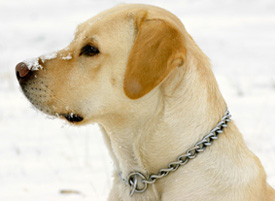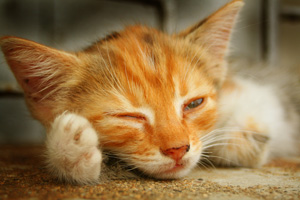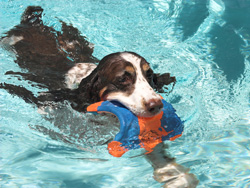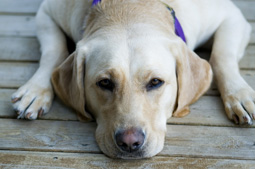Seasonal Pet Care Tips from Grand Rapids Veterinary Clinic
Choose A Season: Spring | Summer | Fall | Winter
Keep Your Pet Warm This Winter
Cold weather can be hard on pets, just like it can be hard on people. Sometimes owners forget that their pets are just as accustomed to the warm shelter of the indoors as they are. Some owners will leave their animals outside for extended periods of time, thinking that all animals are adapted to live outdoors.  This can put their pets in danger of serious illness. There are things you can do to keep your animal warm and safe.
This can put their pets in danger of serious illness. There are things you can do to keep your animal warm and safe.
- Take your animals for a winter check-up before winter kicks in.
- Keep your pets inside as much as you can when the mercury drops. If you have to take them out, stay outside with them. When you're cold enough to go inside, they probably are too.
- If you absolutely must leave them outside for a significant length of time, make sure they have a warm, solid shelter against the wind, thick bedding, and plenty of non-frozen water. Try leaving out a hot water bottle, wrapped in a towel so it won't burn your pet's skin. Some animals can remain outside safely longer in the winter than others.
- In some cases, it's just common sense: long-haired breeds like Huskies will do better in cold weather than short-haired breeds like Dachshunds. Cats and small dogs that have to wade shoulder-deep in the snow will feel the cold sooner than larger animals. Your pet's health will also affect how long she can stay out.
- Animals that are not generally in good health shouldn't be exposed to winter weather for a long period of time. Conditions like diabetes, heart disease, kidney disease, and hormonal imbalances can compromise a pet's ability to regulate her own body heat.. Very young and very old animals are vulnerable to the cold as well.
- No pets should stay outside for unlimited amounts of time in freezing cold weather. If you have any questions about how long your pet should be out this winter, ask your veterinarian.
- If you live near a pond or lake, be very cautious about letting your rambunctious dog off the leash. Animals can easily fall through the ice, and it is very difficult for them to escape on their own. If you must let your dogs loose near open water, stay with them at all times.
- Cats will curl up against almost anything to stay warm--including car engines. Before you turn your engine on, check beneath the car or make a lot of noise by honking the horn or rapping on the hood.
- If you light a fire or plug in a space heater to keep your home toasty warm, remember that the heat will be as attractive to your pets as to you. As your dog or cat snuggles up to the warmth, keep an eye out to make sure that no tails or paws come in contact with flames, heating coils, or hot surfaces. Pets can either burn themselves or knock a heat source over and put the entire household in danger.
- It's a good idea to have your furnace checked for carbon monoxide leakage before you turn it on, both for your pets' health and your own. Carbon monoxide is odorless and invisible, but it can cause problems ranging from headaches and fatigue to trouble breathing. Pets generally spend more time in the home than owners, particularly in the winter, so they are more vulnerable to carbon monoxide poisoning than the rest of the family.
- Pets that go outside can pick up rock salt, ice, and chemical ice melts in their foot pads. To keep your pet's pads from getting chapped and raw, wipe her feet with a washcloth when she comes inside. This will also keep her from licking the salt off her feet, which could cause an inflammation of her digestive tract. If left alone outside, dogs and cats can be very resourceful in their search for warm shelter.
- Provide them with quality, easily accessible shelter. They can dig into snow banks or hide under porches or in dumpsters, window wells, or cellars, and they can occasionally get trapped. Watch them closely when they are loose outdoors, and Keep an eye on your pet's water.
- Sometimes owners don't realize that a water bowl has frozen and their pet can't get anything to drink. Animals that don't have access to clean, unfrozen water are more likely to drink out of puddles or gutters, which can be polluted with oil, antifreeze, household cleaners, and other chemicals.
- Be particularly gentle with elderly and arthritic pets during the winter. The cold can leave their joints extremely stiff and tender, and they may become more awkward than usual. Stay directly below these pets when they are climbing stairs or jumping onto furniture; consider modifying their environment to make it easier for them to get around. Make sure they have a thick, soft bed in a warm room for the chilly nights. Also, watch stiff and arthritic pets if you walk them outside; a bad slip on the ice could be very painful and cause a significant injury. Pets lose most of their body heat from the pads of their feet, their ears, and their respiratory tract. The best way to guard your animals against the cold is keeping a close eye on them to make sure they're comfortable. When you're outside with your pets during the winter, you can watch them for signs of discomfort with the cold. If they whine, shiver, seem anxious, slow down or stop moving, or start to look for warm places to burrow, they're saying they want to get back someplace warm.
- You can also keep an eye out for two serious conditions caused by cold weather.
-
- The first and less common of the two is frostbite. Frostbite happens when an animal's (or a person's) body gets cold and pulls all the blood from the extremities to the center of the body to stay warm. The animal's ears, paws, or tail can get cold enough that ice crystals can form in the tissue and damage it. The tricky thing about frostbite is that it's not immediately obvious. The tissue doesn't show signs of the damage to it for several days. If you suspect your pet may have frostbite, bring her into a warm environment right away. You can soak her extremities in warm water for about 20 minutes to melt the ice crystals and restore circulation. It's important that you don't rub the frostbitten tissue, however--the ice crystals can do a lot of damage to the tissue. Once your pet is warm, wrap her up in some blankets and take her to the veterinarian. Your veterinarian can assess the damage and treat your pet for pain or infection if necessary.
- Hypothermia, or a body temperature that is below normal, is a condition that occurs when an animal is not able to keep her body temperature from falling below normal. It happens when animals spend too much time in cold temperatures, or when animals with poor health or circulation are exposed to cold. In mild cases, animals will shiver and show signs of depression, lethargy, and weakness. As the condition progresses, an animal's muscles will stiffen, her heart and breathing rates will slow down, and she will stop responding to stimuli. If you notice these symptoms, you need to get your pet warm and take her to your veterinarian. You can wrap her in blankets, possibly with a hot water bottle or an electric blanket--as always, wrapped in fabric to prevent against burning the skin. In severe cases, your veterinarian can monitor her heart rate and blood pressure and give warm fluids through an IV. Winter can be a beautiful time of year. It can be a dangerous time as well, but it certainly doesn't have to be. If you take some precautions, you and your pet can have a fabulous time taking in the icicles, the snow banks, and the warm, glowing fire at the end of the day.
- The first and less common of the two is frostbite. Frostbite happens when an animal's (or a person's) body gets cold and pulls all the blood from the extremities to the center of the body to stay warm. The animal's ears, paws, or tail can get cold enough that ice crystals can form in the tissue and damage it. The tricky thing about frostbite is that it's not immediately obvious. The tissue doesn't show signs of the damage to it for several days. If you suspect your pet may have frostbite, bring her into a warm environment right away. You can soak her extremities in warm water for about 20 minutes to melt the ice crystals and restore circulation. It's important that you don't rub the frostbitten tissue, however--the ice crystals can do a lot of damage to the tissue. Once your pet is warm, wrap her up in some blankets and take her to the veterinarian. Your veterinarian can assess the damage and treat your pet for pain or infection if necessary.
(Back to Top)
Spring Allergies Affect Your Pets Too
As new plants and flowers burst into life this spring, so too do the symptoms of hay fever. But humans aren't the only ones who suffer. Blooming plants, grasses and flowers can trigger allergic reactions called atopy in dogs and cats.
 The allergy is similar to hay fever that humans suffer. The animal reacts to inhaled particles such as mold, pollen, and dust. But instead of sneezing, pets typically have itchy skin and will persistently scratch, lick and bite to get relief. Like in human sufferers, the allergy is an inherited predisposition.
The allergy is similar to hay fever that humans suffer. The animal reacts to inhaled particles such as mold, pollen, and dust. But instead of sneezing, pets typically have itchy skin and will persistently scratch, lick and bite to get relief. Like in human sufferers, the allergy is an inherited predisposition.
"If left untreated, dogs and cats with seasonal allergies will scratch or lick themselves constantly," says Dr. Link Welborn, AAHA past president. "In an attempt to relieve themselves, dogs and cats often create sores that become secondary infections."
If the signs of atopy occur for less than three months out of the year, oral medications (like cortisone) may be used to control itching. In more severe cases, pets are given a skin allergy test to pinpoint what allergies the animal is sensitive to. Your veterinarian can then give injections of the allergic material in minimal doses to build up immunities in your pet's system. Other treatments for allergies include immunotherapy, antihistamines, steroids and medicated shampoos.
If you suspect that your pet may be suffering from seasonal allergies, please visit your veterinarian.
Protect Pets From Summer Scorchers
Temperatures are soaring into the 90s and 100s and such intense heat is not only dangerous for humans but for pets as well. The American Animal Hospital Association (AAHA) offers a few tips to protect pets during summer heat waves. Cars are potential death traps during the hot summer months because inside temperatures can quickly climb to more than 120 degrees Farenheit on even a mild sunny day. It's best to leave your pet at home while running errands during hot weather. If your pet lives  outdoors, make sure there is adequate shelter for protection from the midday sun and heat. Outdoor kennels should be well-ventilated and in a shaded area. There should always be some shade for the pet to get out of the sun. Also, make sure there is plenty of fresh drinking water available to your pet. The bowl should be placed in a shaded area where it cannot be heated by the sun. Exercise is important, but overexertion during hot weather commonly causes heat stress. Avoid excessive exercise during hot days. And, keep your pet well-groomed. Long hair and hair mats may need to be clipped to help cool the animal.
outdoors, make sure there is adequate shelter for protection from the midday sun and heat. Outdoor kennels should be well-ventilated and in a shaded area. There should always be some shade for the pet to get out of the sun. Also, make sure there is plenty of fresh drinking water available to your pet. The bowl should be placed in a shaded area where it cannot be heated by the sun. Exercise is important, but overexertion during hot weather commonly causes heat stress. Avoid excessive exercise during hot days. And, keep your pet well-groomed. Long hair and hair mats may need to be clipped to help cool the animal.
Going Camping This Summer? Don't Forget to Pack For Your Pet!
Following is a list of practical items to pack on your trips. Store these items out of the sun in waterproof packs or bags, clean tackle boxes, or similar latching boxes. Out on the trail, carry only emergency items like an extra leash, bandages and tape, and tweezers. Don't forget to pack drinking water and snacks for your pets, too! Leave the rest stored safely back at camp or in the car.
Sample First-Aid Kit
- Gauze bandages and pads
- Wide bandage tape, preferably waterproof
- Scissors, tweezers, and pliers
- Antibiotic cream or ointment, rubbing alcohol, hydrogen peroxide
- Shampoos for skunks and poison ivy/sumac contamination
- Thermometer (protect from excessive heat)
- Instruction sheets from your veterinarian with clinic and emergency telephone numbers
Your Dog's Suitcase
- Dry food in waterproof, airtight containers
- Safe drinking water (do not drink ocean saltwater or creek water)
- Extra snacks for strenuous days (see your veterinarian for suggestions)
- Prescription medications (take enough supply for at least three or four extra days)
- Extra leashes and collars
- Identification tags with current address and phone, current rabies tag
- Blankets and towels
- Brush and comb
- Spray bottles for water and rubbing alcohol (To cool your pet off, use alcohol on foot pads, water on the face and body. Label bottles clearly.)
- Favorite toys and chew bones
Help Your Pet Avoid Heatstroke This Summer & Fall
Heatstroke
You've heard of it, you knew it affected people, and you were even vaguely aware that it could affect your pet. But how does it happen? And most important, how can you help your pet avoid it? Heatstroke is a deadly disease that can kill your beloved companion, even with emergency treatment. The best way to avoid this terrible situation is prevention, and it's all up to you.
 Sun + humidity = heatstroke (and other factors that kill)
Sun + humidity = heatstroke (and other factors that kill)
Everyone knows that the inside of a car on a hot summer's day can be lethal. But Fido needs you to know more than that to keep him safe in the deadly sun. Days above 90 degrees, especially with high humidity, are inherently dangerous for your pet. Humidity interferes with animals' ability to rid themselves of excess body heat. When we overheat we sweat, and when the sweat dries it takes excess heat with it. Our four-legged friends only perspire around their paws, which is not enough to cool the body. To rid themselves of excess heat, animals pant. Air moves through the nasal passages, which picks up excess heat from the body. As it is expelled through the mouth, the extra heat leaves along with it. Although this is a very efficient way to control body heat, it is severely limited in areas of high humidity or when the animal is in close quarters.
The shape of an animal's nasal passages can contribute to an animal's tendency to overheat. Brachiocephalic (pug-nosed) dogs are more prone to heatstroke because their nasal passages are smaller and it's more difficult for them to circulate sufficient air for cooling. Overweight dogs are also more prone to overheating because their extra layers of fat act as insulation, which traps heat in their bodies and restricts their breathing capabilities. Age can also be a factor in an animal's tendency to overheat--very young animals may not have a fully developed temperature regulating system, and older pets' organ systems may not be functioning at 100 percent, leaving them prone to heat-related damage.
Cracking the windows doesn't cut it.
So where are the danger zones? The most obvious is your car: It can become a death trap even on a mild sunny day--and can insidiously raise the car's temperature to well above 120 degrees! Never, ever leave your pet inside the car. If Fido can't come with you when you get out of the car, leave him at home.
What are some other dangerous situations for your pets? Leaving animals outdoors without shelter is just as dangerous as leaving them inside a hot car. Be sure they are not left in a cage in the hot sun, on a chain in the backyard, or outdoors in a run without sufficient shade or air circulation.
Signs of Heatstroke
- Panting
- Staring
- Anxious expression
- Refusal to obey commands
- Warm, dry skin
- High fever
- Rapid heartbeat
- Vomiting
- Collapse
Their lives are in your hands!
Heatstroke is a medical emergency. If you suspect your pet has heatstroke (see "Signs of Heatstroke," above), you must act quickly and calmly. Have someone call a veterinarian immediately. In the meantime, lower the animal's body temperature by applying towels soaked in cool water to the hairless areas of the body. Often the pet will respond after only a few minutes of cooling, only to falter again with his temperature soaring back up or falling to well below what is normal. With this in mind, remember that it is imperative to get the animal to a veterinarian immediately. Once your pet is in the veterinarian's care, treatment may include further cooling techniques, intravenous fluid therapy to counter shock, or medication to prevent or reverse brain damage.
Preventing Heat Stroke
- Provide plenty of fresh water in a bowl that cannot be tipped over
- Ensure adequate shelter from sun/midday heat
- Outdoor kennels should be well-ventilated and in the shade
- Avoid excessive exercise on hot days
- Talk with your local veterinarian to determine if your long-haired Fido needs a summer haircut
Even with emergency treatment, heatstroke can be fatal. The best cure is prevention, and Fido and Fluffy are relying on you to keep them out of harm's way. Summer does not have to be fraught with peril--with ample precaution, both you and your furry friends can enjoy those long, hot, dog-days of summer.

